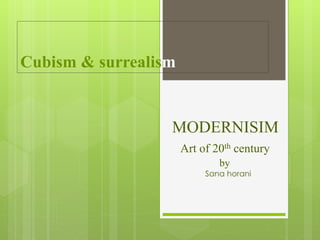Cubism & surrealism [autosaved]
- 1. Cubism & surrealism MODERNISIM Art of 20th century by Sana horani
- 2. What is Cubism ? ď‚› First abstract art style ď‚› Used simple shapes ď‚› Ignored color in beginning ď‚› Lacks elements of light, atmosphere, and space ď‚› Gave depth and richness to painting ď‚› Overlapping Fragments ď‚› Reality of objects in space, reality of flat painted surface
- 3. How did Cubism get its name? Cubism got its name from remarks from the painter Henri Matisse and critic Louis Vauxcelles. They saw Braque’s work " Houses at L'Estaque & quot; and mocked it saying “everything is broken down into cubes.”
- 4. Cubism Influence ď‚› Post Impressionist Gauguin greatly influence Pablo Picasso
- 5. ď‚› Impressionist Cezanne greatly influenced George Braque. Taught to break away from technique and concentrate on color and power of single brush stroke Disengages with detail and simplified a painting
- 6. African greatly influenced Picasso’s early works Direct reaction to Fauvism .Formal simplification and expressive power Based from African and Iberian sculptures Used earth tones similar to the African masks Large inspiration for Picasso
- 7. movements of cubism ď‚› Analytic Cubism (1909-1911) First Cubism phase Monochromatic colors (tans, browns, grays, creams, greens, blues) Based on reducing natural forms to basic geometrical parts. Focused more on intellect than emotion and very ambitious ď‚› Synthetic Cubism (1912-1919) Grew out of analytical Wider use of color Wider use of materials Paper Collage introduced Type of collage Appealing and easier to interpret Less intricate Added substances like sand to paint to make it appear thicker
- 8. Analytic vs Synthetic ď‚› Based on intellect ď‚› Monochromatic color palette ď‚› Reduce object to basic geometric shapes ď‚› Linear construction ď‚› Less intricate ď‚› More color ď‚› More appealing Collage ď‚› Objects less recognizable ď‚› Less shading ď‚› Added substance to paint
- 9. Main Artists:  Pablo Picasso  George Braque  Juan Gris
- 10. Pablo Picasso (1881-1973) o Spanish painter and sculptor o Took the sculpture approach o which lead to creation of Cubism o Stated forms and volumes in basic simplicity
- 15. George Braque (1882-1963) ď‚› French painter ď‚› Saw solid reality of objects ď‚› Impressionist, Fauvist, then Cubist ď‚› Painted mainly scenery ď‚› Influenced by Latisse and the Fauves, then Cezanne and Picasso ď‚› Introduced faux bois. (The appearance of stenciling in his paintings)
- 20. surrealism (1924) ď‚› The word surrealism comes from the French word super realism. The Surrealists wanted to create art that included their unconscious thoughts and dreams. Instead of thinking too much about what they are painting, they preferred to set their imaginations free. Surreal was ď‚› Odd ď‚› Illogical ď‚› Irrational ď‚› Exciting ď‚› Disturbing
- 21. Characteristics of Surrealism ď‚› Reaction to chaos of WWI ď‚› Influence of Freud: Dreams and subconscious ď‚› Impossible scale ď‚› Reversal of natural laws ď‚› Double images ď‚› Juxtaposition ď‚› Element of surprise ď‚› No guideline Free association ď‚› Hidden Images ď‚› Uncensored thought ď‚› Distorted objects ď‚› Transparency. Cooler colors ď‚› Displacement of an object ď‚› Exaggeration
- 22. Kinds of surrealism Automatic Surrealism In the beginning of the Surrealism movement, was prominent. It was used as a means to illustrate the subconscious. In this art, the hand can move freely and randomly across the canvas. Max Ernst coined the term frottage, which is also used in this automatic style of Surrealism. Sub techniques: ď‚› Automatic Drawing ď‚› Frottage ď‚› Decalcomania
- 23. Automatic Drawing Andre Automatic Drawing 1924 moving a pencil or brush randomly across the canvas.
- 24. Frottage Isaac Bingham Palm Tree Frottage Frottage- A pencil rubbing made by putting paper over a textured surface.
- 25. Decalcomania Oscar Dominguez Untitled Decalcomania- pressing textured material or objects into a wet, painted canvas
- 26. Andre Messon Meditation on an Oak Leaf Andre Masson Battle of the Fish 1927 Joan Miro, Carnival of Harlequin , 1924
- 27. Veristic (illusionistic Dream Imagery) The automatism used by Masson and Miro, and Ernst’s “frottage” technique dominated the first year of the Surrealism movement. However, artists like Rene Magritte, Yves Tanguy, and Salvador Dali emerged with a new style in Surrealism. Quite different from previous artists, these artists focused on hallucinatory and fantastic subject matter in meticulously and realistically portrayed images.
- 28. Salvador Dali The Persistence of Memory











![Cubism & surrealism [autosaved]](https://image.slidesharecdn.com/cubismsurrealismautosaved-140605111756-phpapp02/85/Cubism-surrealism-autosaved-11-320.jpg)
![Cubism & surrealism [autosaved]](https://image.slidesharecdn.com/cubismsurrealismautosaved-140605111756-phpapp02/85/Cubism-surrealism-autosaved-12-320.jpg)
![Cubism & surrealism [autosaved]](https://image.slidesharecdn.com/cubismsurrealismautosaved-140605111756-phpapp02/85/Cubism-surrealism-autosaved-13-320.jpg)
![Cubism & surrealism [autosaved]](https://image.slidesharecdn.com/cubismsurrealismautosaved-140605111756-phpapp02/85/Cubism-surrealism-autosaved-14-320.jpg)

![Cubism & surrealism [autosaved]](https://image.slidesharecdn.com/cubismsurrealismautosaved-140605111756-phpapp02/85/Cubism-surrealism-autosaved-16-320.jpg)
![Cubism & surrealism [autosaved]](https://image.slidesharecdn.com/cubismsurrealismautosaved-140605111756-phpapp02/85/Cubism-surrealism-autosaved-17-320.jpg)
![Cubism & surrealism [autosaved]](https://image.slidesharecdn.com/cubismsurrealismautosaved-140605111756-phpapp02/85/Cubism-surrealism-autosaved-18-320.jpg)
![Cubism & surrealism [autosaved]](https://image.slidesharecdn.com/cubismsurrealismautosaved-140605111756-phpapp02/85/Cubism-surrealism-autosaved-19-320.jpg)









![Cubism & surrealism [autosaved]](https://image.slidesharecdn.com/cubismsurrealismautosaved-140605111756-phpapp02/85/Cubism-surrealism-autosaved-29-320.jpg)
![Cubism & surrealism [autosaved]](https://image.slidesharecdn.com/cubismsurrealismautosaved-140605111756-phpapp02/85/Cubism-surrealism-autosaved-30-320.jpg)
![Cubism & surrealism [autosaved]](https://image.slidesharecdn.com/cubismsurrealismautosaved-140605111756-phpapp02/85/Cubism-surrealism-autosaved-31-320.jpg)
![Cubism & surrealism [autosaved]](https://image.slidesharecdn.com/cubismsurrealismautosaved-140605111756-phpapp02/85/Cubism-surrealism-autosaved-32-320.jpg)
![Cubism & surrealism [autosaved]](https://image.slidesharecdn.com/cubismsurrealismautosaved-140605111756-phpapp02/85/Cubism-surrealism-autosaved-33-320.jpg)
![Cubism & surrealism [autosaved]](https://image.slidesharecdn.com/cubismsurrealismautosaved-140605111756-phpapp02/85/Cubism-surrealism-autosaved-34-320.jpg)
![Cubism & surrealism [autosaved]](https://image.slidesharecdn.com/cubismsurrealismautosaved-140605111756-phpapp02/85/Cubism-surrealism-autosaved-35-320.jpg)
![Cubism & surrealism [autosaved]](https://image.slidesharecdn.com/cubismsurrealismautosaved-140605111756-phpapp02/85/Cubism-surrealism-autosaved-36-320.jpg)